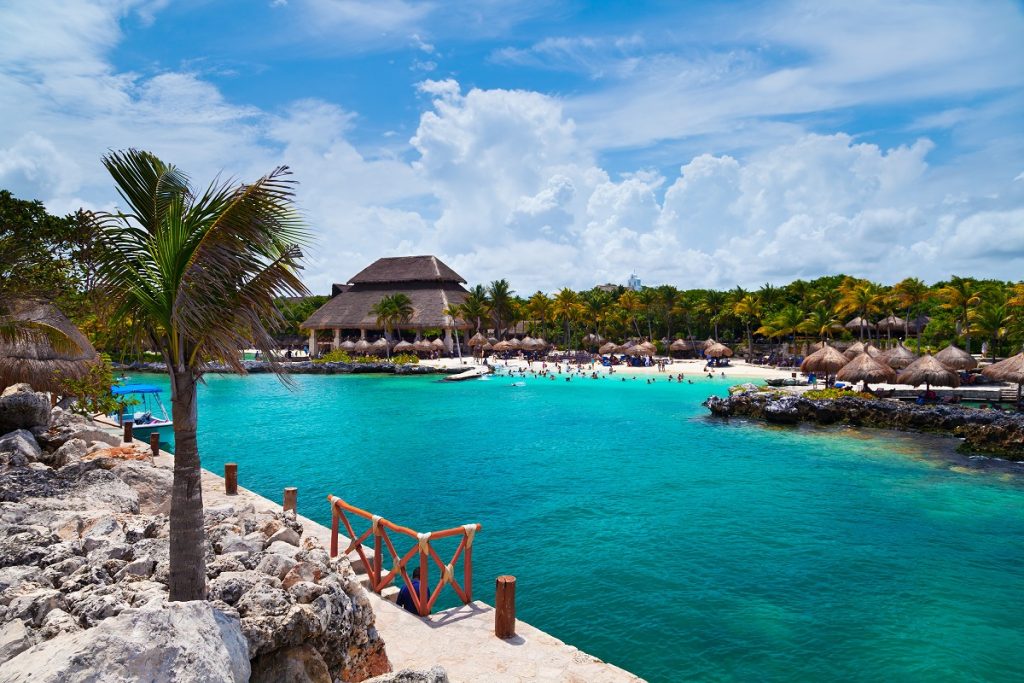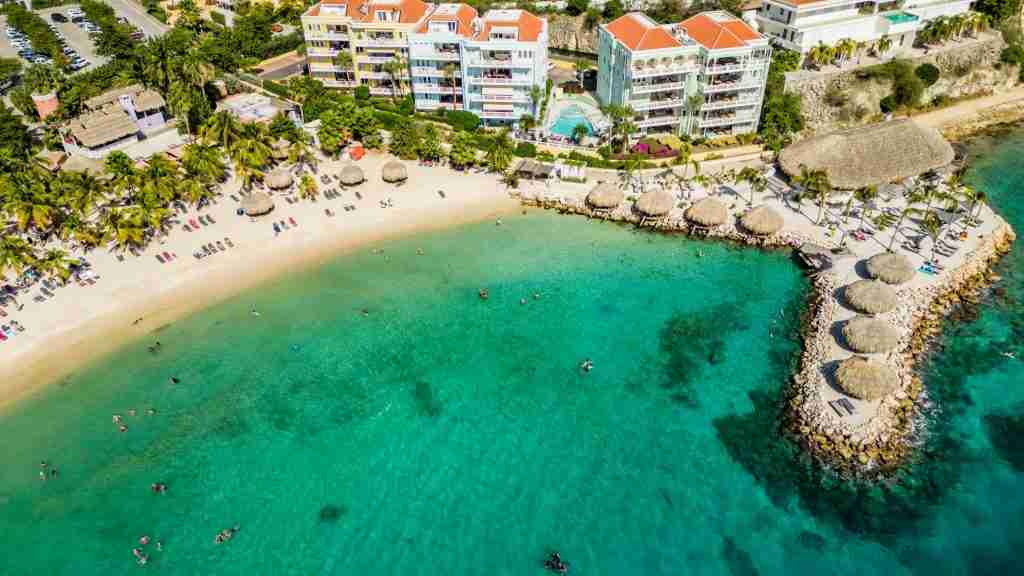1. Exploring the best beaches in Curaçao
Curaçao is a Caribbean destination famous for its white sand beaches and turquoise waters. Each one offers something special, from tranquility to water adventures, making the island a paradise for sun and sea lovers.
Cas Abao Beach is one of the best known for its breathtaking landscapes. With crystal clear waters and a gentle slope, this beach is ideal for families and divers and snorkelers. The natural environment, surrounded by palm trees, and the possibility of relaxing under the sun make this place one of the most appreciated.

Another prominent beach is Kenepa Beach, famous for its panoramic views and clear waters. This place is perfect for those looking for a more relaxed and less crowded experience. The blue waters and the cliffs that surround it offer a unique beauty, attracting photographers and visitors looking for a picturesque corner.
Mambo Beach offers a different environment, ideal for those looking for more than just sun and sand. This beach combines entertainment and relaxation, with bars and restaurants lining up along the coast. Here it is common to see tourists enjoy music while contemplating the sunset, which makes Mambo Beach one of the liveliest destinations in Curaçao.
For those who prefer something more unique, Playa Forti is an interesting option. Although more rocky than the others, its elevated location makes it popular among those looking for thrills, such as jumping from cliffs into the water. The views from this beach are spectacular, and although it does not have the typical white sand, it is an excellent place for diving.
Curaçao offers a variety of beaches for all tastes, each with its own charm and unique characteristics. From beaches full of life and activities to quiet and serene coves, this destination is perfect for those looking to enjoy the natural beauty of the Caribbean.
2. Unmissable attractions in Curaçao: Culture and Nature
Curaçao is not only famous for its beaches, it also offers a rich mix of culture and stunning natural landscapes. The island has a diverse colonial heritage that is reflected in its architecture, museums and historical sites, as well as in its spectacular natural parks.
One of the most emblematic places of Curaçao is Willemstad, the capital of the island. Its Dutch colonial architecture, with brightly colored buildings, makes the city center a mandatory stop. The floating bridge of the Queen Emma, which connects the neighborhoods of Punda and Otrobanda, is a symbol of the city and offers incredible views of the port and the colorful facades. Walking through these streets is like transporting yourself to the past, while enjoying the vibrant and multicultural atmosphere of the city.
For nature lovers, Shete Boka National Park is a must-see. This park offers stunning views of the rocky coast and is home to various wildlife species, such as sea turtles that frequent its beaches to nest. There are several trails that allow you to explore the dramatic landscapes and enjoy the impressive waves that hit the rock formations.
Another natural wonder is Hato Caves, a system of limestone caves dating back thousands of years. These caves have impressive stalactites, stalagmites and a fascinating history, since they were used as a refuge by escaped slaves. The cave tour offers a look at the island’s unique geology and Curaçao’s historical past.
In addition, Curaçao is a paradise for lovers of diving and snorkeling, with numerous highlights to explore coral reefs and marine life. The Superior Producer shipwreck is one of the most famous dive sites on the island. This sunken ship is home to a wide variety of marine species, from colorful tropical fish to large barracudas, and has become a unique ecosystem.
Curaçao not only offers beaches, but also a rich mix of culture and nature that makes every corner of the island have something special to offer. From its vibrant capital to its nature reserves, the island is a complete destination for all types of travelers.

3. How to get to Curaçao: Guide from Caracas or Amsterdam
Getting to Curaçao is easy, as the island is well connected to several international cities, especially from South America and Europe. If you come from Caracas, the capital of Venezuela, or Amsterdam, the capital of the Netherlands, you have several comfortable and accessible options to get to this Caribbean paradise.
From Caracas, the trip is particularly fast and direct due to the geographical proximity between Venezuela and Curaçao. Local airlines usually offer frequent flights, lasting approximately one hour. This short trip makes Curaçao a popular getaway for Venezuelans looking to relax on the island’s beaches. When you arrive at Hato International Airport, located about 12 kilometers from the center of Willemstad, you will find public transport and taxis that will easily take you to your accommodation.
On the other hand, if you travel from Amsterdam, the journey is longer but equally direct. The KLM airline offers direct flights from Schiphol Airport to Curaçao, lasting approximately 10 hours. This transatlantic flight is very popular, since Curaçao is still part of the Kingdom of the Netherlands, which facilitates connections between the two nations. Once you land at Hato International Airport, you can take a taxi or rent a car to get around the island.
In addition to these two main routes, there are direct flights to Curaçao from several major cities in North America, such as Miami and New York. This makes the island an accessible destination for both European and American travelers.
Depending on the time of year, flight prices may vary. However, it is advisable to book in advance, especially in high season, to make sure you get the best rates. Once on the island, transportation is relatively simple, as Curaçao has a well-maintained road network, perfect for exploring its different beaches and attractions.
Curaçao is within reach of a short flight from South America or a direct flight from Europe, which makes the island an ideal tourist destination for both quick getaways and extended vacations.
4. Tips to make the most of your trip to Curaçao
Curaçao offers an unforgettable experience, but to make sure your trip is perfect, there are some practical tips that will help you make the most of your time on the island. From prior planning to local recommendations, these details will make the difference in your adventure.
Pack properly. Although Curaçao enjoys a warm climate all year round, it is important to wear light clothing and high-quality sunscreen. The Caribbean sun can be very strong, and if you plan to spend a lot of time on the beach or exploring outdoors, being protected is essential. Don’t forget to bring sunglasses, cap or hat, and comfortable footwear in your suitcase, especially if you have in mind to explore nature reserves or go hiking.
Take advantage of local transportation, as renting a car in Curaçao is an excellent option if you plan to explore different areas of the island. Public transport is limited, so having your own vehicle will allow you to move freely, from the most remote beaches to the natural parks. In addition, driving in Curaçao is quite simple, with clear signs and roads in good condition. Just remember to familiarize yourself with local traffic rules before venturing on the roads.
Try the local cuisine, which is a fascinating mix of Caribbean and European flavors. Be sure to visit the local restaurants to try traditional dishes such as “keshi yena”, a cheese-filled dish, or the fresh fish served in many of the seafront restaurants. Street meals, such as those found in local markets, are also a great way to experience the culinary culture of the island. If you are close to Punda, the Plasa Bieu Market is ideal to taste these dishes in an authentic atmosphere.
Immerse yourself in the culture of the island. Not everything in Curaçao revolves around the beaches; spend time exploring the history and culture of the place. Visit museums such as the Kura Hulanda Museum, which offers a look at the colonial past and the history of the slave trade on the island. It is also advisable to stroll through the historic neighborhoods of Willemstad, where colorful buildings and Dutch architecture combine with Caribbean influence.
Finally, consider the best time to travel. Although Curaçao has a pleasant climate throughout the year, the months of May to November are considered low season, which means fewer tourists and lower prices on accommodation and activities. However, the high season, from December to April, offers a more lively atmosphere and special events, ideal if you like to enjoy a vibrant atmosphere.

With these tips, you will be ready to live an unforgettable experience in Curaçao. The combination of paradisiacal beaches, a rich culture, and endless outdoor activities make this island an exceptional destination for any type of traveler. More information about the Virgin Island here. Get ready to relax, explore and enjoy every moment of your stay in this corner of the Caribbean!